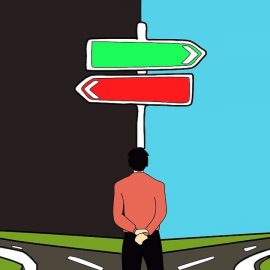
What are the two methods of Stoic training? What do these methods prepare you for?
In The Stoic Challenge, William B. Irvine discusses two methods of training you can use to practice the Stoic strategy. Both training methods help you develop resolve and resourcefulness.
Continue reading if you want to practice these methods yourself to become a modern-day Stoic.
1. Expose Yourself to Unpredictable Adversities
Irvine’s first method of Stoic training is to prepare for real-world setbacks by putting yourself in positions that will probably confront you with unpredictable adversities. If they come along, you have the chance to practice handling the situation as a Stoic would—reframe it as a test, diffuse negative emotions, and find a solution. The point of this training is to get used to the unpredictability of troubles and the task of remembering your strategy, since in normal life, you won’t see adversities coming.
To expose yourself to unpredictable adversities, Irvine says that you should find opportunities to challenge yourself. This could be simple and mundane, like riding your bike to work instead of driving (forcing you to navigate unforeseen troubles along the way) or more ambitious, like learning a difficult new skill. Whatever you choose, it shouldn’t take you too far outside your comfort zone. So if you’re someone who, for instance, doesn’t hike, you’d start with a local forest trail rather than a days-long alpine trek.
According to Irvine, building a new skill is the best kind of challenge you can take on because to learn any skill means navigating numerous unforeseen challenges. This is especially true if you pick a skill that relies on capacities you aren’t strong in—for instance, a powerlifter would likely experience more unpredictable adversities in learning childcare skills than he would from switching to CrossFit.
Over time, opting to keep pushing when the going gets tough will develop your resolve—that is, you’ll get grittier. You’ll become more steadfast in the face of tough challenges, and you’ll get in the habit of not letting your inner laziness control your choices.
2. Seek Out Direct Discomfort
Irvine also recommends that you undergo training that expands your comfort zone. Whereas the challenge-based training above has you seeking possible adversity, this training involves going out of your way to get uncomfortable. In this case, the adversities won’t be unexpected (you’ll train for that as above) but rather intense and challenging.
Irvine explains that actively seeking adversity will expand your comfort zone, empowering you to remain tranquil and even experience delight in a wider range of circumstances. The greater the levels of intensity you can get used to, the better equipped you’ll be to handle intense, real-world adversities. This training has two dimensions: emotional toughening and physical toughening.
Emotional toughening is when you practice facing your fears in order to expand your comfort zone. Irvine recommends that you gradually expose yourself to what you’re afraid of (such as handling dogs) and intensify the challenge over time.
Physical toughening is when you train your body by exposing yourself to increasingly intense physical stressors. Irvine suggests extreme temperature training, physical exercise, dieting and fasting, and endurance training.
Irvine explains that an added benefit of training in these ways is that the Stoics would experience greater pleasure from lesser indulgence. That is, toughening yourself up with Stoic-style training—living in bare, austere conditions and seeking out challenges—has the side effect of making worldly pleasures seem all the more wonderful if they happen to come along.
In contrast, people who constantly indulge grow used to pleasure and thereby lose their ability to enjoy it. They become so physically and emotionally soft that even slight discomfort will seem unbearable. According to Irvine, this implies that in the long run, intentionally seeking and getting used to discomfort reduces it better than avoiding it does.






